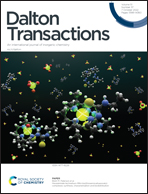Reactions of a Lewis acidic methylene phosphonium cationic adduct with olefins†
Abstract
Efforts to deprotonate the halophosphonium cations [Ph2P(X)Me]+ (X = F, Cl) generated species of the form [Ph2(X)PC(H)PPh2Me][X′]. The derivative where X = O3SCF3 provides access to a methylene phosphonium cation. The coordinated triflate anion can be replaced by Et3PO and dimethylaminopyridine (DMAP). In addition, the cation reacts with the olefins R2C![[double bond, length as m-dash]](https://www.rsc.org/images/entities/char_e001.gif) CH2 (R = Ph, Me) and PhMeC
CH2 (R = Ph, Me) and PhMeC![[double bond, length as m-dash]](https://www.rsc.org/images/entities/char_e001.gif) CH2. While Ph2C
CH2. While Ph2C![[double bond, length as m-dash]](https://www.rsc.org/images/entities/char_e001.gif) CH2 was shown to give the species [Ph2(Ph2CCH)PCH2PPh2Me][O3SCF3]2 with a pendant vinyl group, reactions with methyl substituted olefins undergo additional isomerization to form [Ph2(RCH2CCH2)PCH2PPh2Me][O3SCF3]2 (R = Ph, Me) featuring pendant allyl moieties.
CH2 was shown to give the species [Ph2(Ph2CCH)PCH2PPh2Me][O3SCF3]2 with a pendant vinyl group, reactions with methyl substituted olefins undergo additional isomerization to form [Ph2(RCH2CCH2)PCH2PPh2Me][O3SCF3]2 (R = Ph, Me) featuring pendant allyl moieties.



 Please wait while we load your content...
Please wait while we load your content...